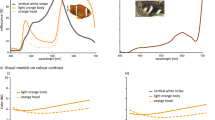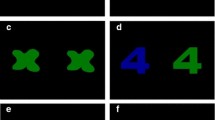Abstract
In this study, we measured aerial visual acuity in harbor seals. As a first approach to the hypothesis that harbor seals can obtain acute aerial visual acuity mediated by the interaction of the vertical slit-shaped pupil and the corneal flattening although refractive measurements had revealed aerial myopia, visual acuity was tested as a function of luminance and pupil dilation. We analyzed aerial visual acuity (minimal resolvable stripe width) in three harbor seals in a two-alternative-forced-choice discrimination experiment. Our results further support the hypothesis that harbor seals possess an aerial visual acuity comparable to the acuity in clear waters if the vertical slit pupil does not exceed the zone of corneal flattening in bright light. When the pupil dilates with decreasing luminance, visual acuity decreases which might be due to deflected light from the stronger curved peripheral cornea.



Similar content being viewed by others
Abbreviations
- IR:
-
Infrared
- SD:
-
Standard deviation
References
Busch H, Dücker G (1987) Das visuelle Leistungsvermögen der Seebären (Arctocephalus pusillus und Arctocephalus australis). Zool Anz 219(3/4):197–224
Dawson WW, Schroeder JP, Sharpe SN (1987) Corneal surface properties of two marine mammal species. Mar Mamm Sci 3(2):186–197
Gellermann LW (1933) Chance orders of alternating stimuli in visual discrimination experiments. J Gen Psychol 42:206–208
Hanke FD, Dehnhardt G, Schaeffel F, Hanke W (2006) Corneal topography, refractive state, and accommodation in harbor seals (Phoca vitulina). Vision Res 46:837–847
Hanke FD, Kröger RHH, Siebert U, Dehnhardt G (2008) Multifocal lenses in a monochromat, the harbour seal. J Exp Biol 211:3315–3322
Hanke W, Römer R, Dehnhardt G (2006) Visual fields and eye movements in a harbor seal (Phoca vitulina). Vision Res 46:2804–2814
Jamieson GS (1970) The eye of the harbor seal, Phoca vitulina (PhD thesis). The University of British Columbia, Vancouver
Jamieson GS, Fisher HD (1970) Visual discrimination in the harbour seal, Phoca vitulina, above and below water. Vision Res 10:1175–1180
Jamieson GS, Fisher HD (1971) The retina of the harbour seal, Phoca vitulina. Can J Zool 49:19–23
Jamieson GS, Fisher HD (1972) The pinniped eye: a review. In: Harrison RJ (ed) Functional anatomy of marine mammals. Academic Press, London, pp 245–261
Johnson GL (1893) Observations on the refraction and vision of the seal’s eye. Proc Zool Soc Lond 719–723
Johnson GL (1901) Contributions to the comparative anatomy of the mammalian eye, chiefly based on ophthalmoscopic examination. Phil Trans R Soc Biol Char 194:1–82
Land MF, Nilsson D-E (2002) Animal eyes. Oxford University Press, Oxford
Mass AM, Supin AY (1992) Peak density, size and regional distribution of ganglion cells in the retina of the fur seal Callorhinus ursinus. Brain Behav Evol 39:69–76
Mass AM, Supin AY (2003) Retinal topography of the harp seal Pagophilus groenlandicus. Brain Behav Evol 62:212–222
Mass AM, Supin AY (2005) Ganglion cell topography and retinal resolution of the Steller sea lion (Eumetobias jubatus). Aquat Mamm 31(4):393–402
Peichl L, Moutairou K (1998) Absence of short-wavelength sensitive cones in the retinae of seals (Carnivora) and African giant rats (Rodentia). Europ J Neurosci 10:2586–2594
Peichl L, Behrmann G, Kröger RHH (2001) For whales and seals the ocean is not blue: a visual pigment loss in marine mammals. Europ J Neurosci 13:1520–1528
Rahmann H (1967) Die Sehschärfe bei Wirbeltieren. Nat Rundsch 1:10–14
Schaeffel F, Farkas L, Howland HC (1987) Infrared photoretinoscope. Appl Opt 26(8):1505–1508
Schusterman RJ, Balliet RF (1970) Visual acuity of the harbour seal and the Steller sea lion under water. Nature 226:563–564
Schusterman RJ, Balliet RF (1971) Aerial and underwater visual acuity in the California sea lion (Zalophus californianus) as a function of luminance. Ann N Y Acad Sci 188:37–46
Sivak JG (1980) Accommodation in vertebrates: a contemporary survey. Curr Top Eye Res 3:281–330
Walls GL (1942) The vertebrate eye and its adaptive radiation. Hafner Press, New York
Wässle H (2004) Parallel processing in the mammalian retina. Nat Rev Neurosci 5:747–757
Weiffen M, Möller B, Mauck B, Dehnhardt G (2006) Effect of water turbidity on the visual acuity of harbor seals (Phoca vitulina). Vision Res 46:1777–1783
Woodhouse JM (1975) The effect of pupil size on grating detection at various contrast levels. Vision Res 15:645–648
Acknowledgments
The authors would like to thank Christine Scholtyssek and Wolf Hanke for critically reading the manuscript. This study was supported by a grant of the Studienstiftung des Deutschen Volkes (2005 SA 0969) to FDH and grants of the VolkswagenStiftung and the Deutsche Forschungsgemeinschaft (SFB 509) to GD. The experiments were in line with the current German law on the protection of animals.
Author information
Authors and Affiliations
Corresponding author
Rights and permissions
About this article
Cite this article
Hanke, F.D., Dehnhardt, G. Aerial visual acuity in harbor seals (Phoca vitulina) as a function of luminance. J Comp Physiol A 195, 643–650 (2009). https://doi.org/10.1007/s00359-009-0439-2
Received:
Revised:
Accepted:
Published:
Issue Date:
DOI: https://doi.org/10.1007/s00359-009-0439-2




